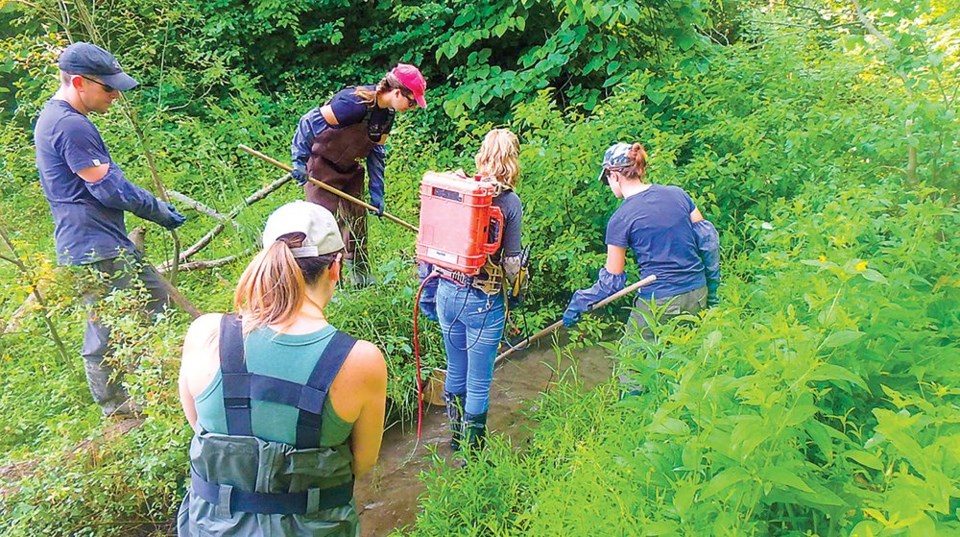Nature Conservancy will hold a virtual public meeting
Restoration work on the Lathrop Nature Preserve, in Fonthill, is scheduled to begin this fall. The Nature Conservancy of Canada (NCC), owners of the property, have embarked on a $660,000 project to reduce the effects of two man-made ponds on the fragile environment, and improve the trails along the old railway berm, which is deteriorating.
Working in partnership with the Niagara Chapter of Trout Unlimited Canada (TUC) and Niagara College, along with their contracted project managers, GEI Consultants, NCC has completed the study and planning stages of the project and are now ready to begin on-site restoration work. While $100,000 remains to be raised by the organization, they are ready for the initial stages of construction.
The two ponds on the property were created more than a hundred years ago when the railway berm was constructed to service the cannery that is now Spring Valley Apartments. Water trickling from these ponds through the berm enters a tributary of Twelve Mile Creek, and the NCC and their partners are concerned about the warming effect this has on what the Conservancy refers to as the “last remaining cold-water creek in Niagara” during the summer months. In addition, the berm supports the main trail used by walkers in the Preserve, and the water leaching through has severely weakened the integrity of the embankment and could pose a danger to those using the trails.
The proposed design for reconstruction will divert water from the ponds and channel it to connect with the creek without compromising the berm. Plans call for the trail to be strengthened and a boardwalk added where necessary. During the construction phase of the project, the trails will be closed off and signage will direct walkers to detour around the area. Access for machinery to reach the site will be built from Haist Street rather than the normal pedestrian entrance off North Pelham Street. NCC Conservation Biologist, Liv Monck-Whipp, says that the access will be carefully planned to cut as few trees as possible, and minimize damage to the dense forest floor.
According to Heather Whitehouse, a senior ecologist with GEI, the ponds created an interesting challenge that forced the company to rethink its original intention to remove them.
“At the outset of our restoration project, we conducted new baseline wildlife studies at the two ponds,” said Whitehouse. “In the process, we observed that the ponds provided overwintering and foraging habitat for two turtle species of concern. So … the restoration target to improve downstream cold-water fish habitat by removing the ponds would conflict with the restoration vision of maintaining and enhancing the biodiversity of the project site.”
We observed that the ponds provided overwintering and foraging habitat for two turtle species of concern
The resulting redesign preserves the ponds while creating a new tributary that will connect the source water to the Twelve Mile Creek tributaries. Unfortunately, the ponds have become a dumping ground for unwanted pet goldfish, and this invasive and destructive species is now the primary fish in the ponds.
According to Whitehouse, the project has presented other challenges, too. The sensitive Carolinian environment and the many species that live in it needed to be protected, not only once the project is completed, but also during the construction phase.
“As the proposed headwater tributary is within existing wetland and lowland Carolinian forest, we determined the minimum tributary dimensions to reduce disturbing the footprint within this … wetland habitat. Even our construction methods changed. Much of the new tributary will be hand-dug to minimize the impacts of construction on key windows for wildlife habitat, breeding, and overwintering.”
Ian Smith, of Fonthill, is a professional fluvial geomorphologist (a.k.a., “stream guy”) with some 30 years’ experience in stream restoration and projects such as this. He is also a member of the Executive of the Niagara Chapter of TUC dedicated to protecting and improving Twelve Mile Creek. To him, this project is a win for the creek and for Town.
“The Lathrop property represents not only a critical part of the Town of Pelham’s rich natural heritage,” said Smith, “but one of the last natural areas that supports the Niagara region’s only sustainable cold-water stream with the remnants of the Peninsula’s last native trout population. The Nature Conservancy of Canada and its supporters have stepped up and are working to protect this irreplaceable part of Fonthill, Pelham and Niagara.”
The Nature Conservancy of Canada and its supporters have stepped up and are working to protect this irreplaceable part of Fonthill, Pelham and Niagara
Speaking for the NCC, biologist Liv Monck-Whipp emphasized the importance of the NCC’s work in the context of the entire Twelve Mile creek watershed.
“We’re very excited about partnering with Niagara College and Trout Unlimited Canada’s Niagara Chapter,” said Monck-Whipp. “Together, we have conducted extensive restoration work within the Twelve Mile Creek watershed. This project will contribute to that bigger effort to improve water quality and fish habitat in Niagara’s last cold-water creek.”
The Nature Conservancy of Canada takes a unique approach to the protection of natural spaces. Where other organizations like TUC seek to work with landowners through education and assistance with projects to improve and protect the environment, NCC acquires the properties through purchase, grant, or legacy, and manages them as the owner. It is the nation's leading not-for-profit, private land conservation organization, working to protect important natural areas and the species they sustain. Since 1962, NCC and its partners have helped to protect 14 million hectares (35 million acres), coast to coast to coast, with some 84,000 hectares (207,000 acres) in Ontario. The Lathrop property was donated to NCC in 1998 by Dr. D. Whiting and Margaret Lathrop.
To learn about the project’s purpose, design, and timelines, the public is invited to a virtual information session on August 19th from 7 to 8 PM. Registration at the NCC website natureconservaancy.ca/lathrop is required.



